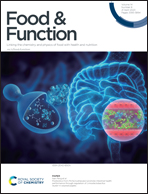Allergenicity evaluation of five types of commercial food-derived oligopeptide products†
Abstract
Food-derived oligopeptides are low in molecular weight and have a variety of biological activities. However, many of them are derived from allergens, which may pose a threat to allergic consumers. This study aimed to assess the allergenicity of five types of oligopeptides industrially derived from allergenic foods (soybean, wheat, oyster, salmon skin, and haddock skin). Referring to the decision tree proposed by the FAO/WHO for the allergenicity evaluation of genetically modified food, we included three kinds of bioinformatic tools (AlgPred, AllerCatPro, and AllerTOP), SDS-PAGE, ELISA, cell and animal experiments in this study. The variation of effector levels (IL-4, IFN-γ, His, and mMCP-1) was determined in mouse models. The results revealed that the oligopeptides were all predicted to contain allergenic peptides, of which the soybean one had the highest number of allergenic peptides. Moreover, there were anti-enzymatic peptides present in the soybean oligopeptide. Unexpectedly, the serum IgE binding ability of the peptides was lower than the positive threshold. In addition, no statistical divergence was found between the oligopeptide groups and the control groups in the effector and β-hexosaminidase levels. Overall, the five types of oligopeptides, though derived from allergens, had low allergenicity.



 Please wait while we load your content...
Please wait while we load your content...